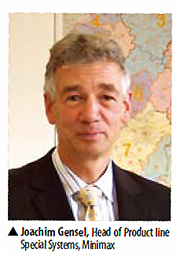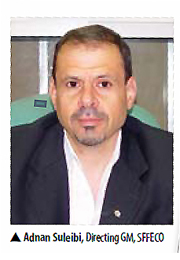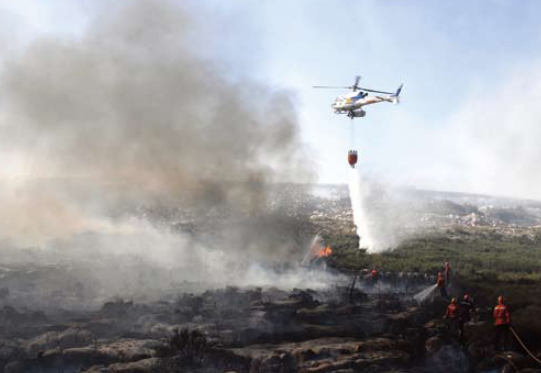A fire protection system is incomplete without fire suppression. Once an alarm activates to indicate a fire hazard, the fire suppression system kicks in to contain and choke off the fire before damages are caused.
A fire protection system is incomplete without fire suppression. Once an alarm activates to indicate a fire hazard, the fire suppression system kicks in to contain and choke off the fire before damages are caused.
All facilities should be adequately equipped with a fire suppression system designed to suit their needs. “Highly susceptible industries such as chemical, petrochemical, mining, and oil and gas, all face the risk of potentially devastating fire hazards on a day to day basis,” said Jason Ng, Marketing Communications Manager, Tyco Fire Suppression & Building Products, in a prepared statement.
In the event of a fire, heat and smoke will activate the fire alarm system, which releases agents to extinguish the fire. The fire alarm and fire suppression systems work hand in hand to protect the safety of an environment. “Fire suppression systems are required to be monitored by the building's fire alarm system,” said Chris Jelenewicz, Engineering Program Manager, Society of Fire Protection Engineers. “When automatic sprinkler systems are installed, the fire alarm system monitors water flow, drops in water pressure (for certain systems) and valve tamper switches. Automatic sprinklers operate at a predetermined temperature, and activation is determined upon the sprinkler's distance to the heat source and the conditions that it is protecting.”
For gaseous systems, smoke or heat detectors activate the system,” Jelenewicz said. “In addition to suppression systems, the fire alarm system may also interface with building elevators, smoke management systems, security systems and HVAC systems.” There are two ways to activate a fire suppression system: mechanical activation and electrical activation.
Mechanical activation occurs when modular extinguisher systems activate by a broken bulb, which cracks at a certain temperature. At the same time, the agent or water is released into the protected enclosure to suppress the fire. Activation depends on different pressure settings, said Adnan Suleibi, Directing GM, SFFECO.
Electrical activation describes the releasing of clean agents and water-based spray systems by an automatic detection system. "The system's main control valve receives a signal from the extinguishing control panel, which is preconfigured with actuation stages and delays based on user requirements," Suleibi said.
There are two types of fire suppression agents used in fire protection systems — water-based and gaseous fire-extinguishing agents. “It is vital that these systems are designed, installed and maintained properly,” Jelenewicz said.
WATER SYSTEMS
A water-based fire suppression unit uses a sprinkler, which is a thermo-sensitive device that activates when the heat in a room reaches a preset level. “The most common type of water-based system is the automatic sprinkler system,” Jelenewics said.
 Sprinklers systems must have a continuous supply of water. “In residential applications, they are linked to a pipe system, which accesses the public water supply,” said Joachim Gensel, Head of Product Line Special Systems, Minimax. “In a commercial building, however, the pipe system is most likely attached to a water tank.”
Sprinklers systems must have a continuous supply of water. “In residential applications, they are linked to a pipe system, which accesses the public water supply,” said Joachim Gensel, Head of Product Line Special Systems, Minimax. “In a commercial building, however, the pipe system is most likely attached to a water tank.”
Water as a suppression agent is also commonly used in forest fires, due to their nontoxicity and low cost, Gensel said.
Sprinkler systems are preferred for both residential and commercial buildings, due to their low cost and safety. “However, special considerations must be given to areas where water can further aggravate the problem or damage water-sensitive assets, such as a server room,” Suleibi said.
FOAM
Foam is predominantly used to extinguish flammable and combustible liquid fires, Jelenewicz said. “These systems use a foam concentrate mixed with water which expandeds with air to create foam. There are a number of foam firefighting agents available, and they are classified as low, medium or high expansion.”
Foam needs to be mixed. Thus they are not used in automatic systems, but mostly in handheld fire extinguishers. They work by covering the burning item in a sheet of foam, successfully cutting off the oxygen supply for the fire and preventing the release of toxic vapors.
This type of fire suppressant can also be used to combat burning paper, plastics, and rubber. “They are also widely used with foam pourers attached to an aircraft for putting out hazards covering large outdoor areas,” Suleibi said.
 GAS SYSTEMS
GAS SYSTEMS
There are many circumstances where water cannot be used as an effective fire suppressant. “Gaseous fire-extinguishing agents are often used for special hazards that cannot be adequately protected by fire sprinkler systems. These extinguishing agents are also utilized where the application of water may cause excessive collateral damage or an interruption of critical operations,” Jelenewicz said.
Carbon dioxide is most commonly used due to its effectiveness in reducing oxygen and its cooling effect, which can be used for deep-seated fires. “It is low-cost, accepted and easily available, and every country is familiar with it and has standards regarding the usage of it as a fire suppressant,” Gensel said. Its ability to extinguish fire is remarkable — a mere few seconds to choke off the oxygen supply in a room.
The ability to remove all the oxygen in a room in such a short time period makes carbon dioxide systems effective for extinguishing combustible materials. “However, it must be used in total flooding applications and these systems produce lethal concentrations of carbon dioxide in the protected space,” Jelenewicz said. “Consequently, carbon dioxide is not recommended for use as an extinguishing agent in normally occupied spaces.“
Extra steps are taken to ensure safety when using carbon dioxide. “After carbon dioxide is released into an enclosed space, fire marshals must test the level of toxicity in the air and make sure most of the gas has dissipated before entry is allowed,” Gensel said.
Asides from carbon dioxide, there are other gaseous agents used in the suppression of fire. Argon and nitrogen, hydrofluocarbons (HFCs) and halon alternatives are all gases used to combat fire. “Argon is the only agent able to suppress class D fires, which involve metals such as magnesium, lithium and aluminum,” Gensel said.
 Such gases cost more compared to widely available carbon dioxide, but contain little or no levels of toxicity. “The room is expected to be quickly evacuated during the 10 to 30-second time frame at the start of the acoustic prealarm,” Gensel said. “If carbon dioxide is released prior to full evacuation, the victim would surely suffer from carbon dioxide poisoning, which can be fatal.”
Such gases cost more compared to widely available carbon dioxide, but contain little or no levels of toxicity. “The room is expected to be quickly evacuated during the 10 to 30-second time frame at the start of the acoustic prealarm,” Gensel said. “If carbon dioxide is released prior to full evacuation, the victim would surely suffer from carbon dioxide poisoning, which can be fatal.”
Compared to carbon dioxide, HFCs or halon replacements are much safer for humans. “These agents are not harmful as long as the design concentration stays below the lowest observed adverse effect level value, which is most often the case,” Gensel said.
HFC is stored as a liquid in pressurized steel containers and vaporizes when released. “It looks exactly like water, but does not cause the type of damage associated with water when putting out a fire,” Ng said. It can be used to protect rare exhibits, electronic equipment and other delicate items without causing any harm. The fire protection fluid will quickly evaporate, safeguarding these items and leaving them unaffected.
The amount of agent needed to extinguish a fire is calculated using a formula that takes into consideration the volume of the room, type of agent and specific characteristics of the material protected. These formulas and guidelines are thoroughly tested by international organizations to insure safety, Gensel said.
HIGH/LOW PRESSURE SYSTEMS
All gaseous suppressants are stored in steel cylinders, and there are two systems for gaseous agents: low-pressure systems and high-pressure systems. Only carbon dioxide can be stored in larger, low-pressure systems. “Low-pressure systems are easier to store, and are most likely installed in large warehouses where water agents cannot be used and large amounts of gas is needed due to the size of the space,” Gensel said. The agent itself is also more suitable for unoccupied spaces.
High-pressure systems are used to house agents such as HFC and halon alternatives, which cost more to store. “They can store smaller volumes of gas meant to protect anywhere from 200 to 500 cubic meters,” Gensel said. “They are widely used in telecommunication rooms and marine engine rooms.“
The steel cylinders are usually stored in a separate room due to space constraints, and attention must be paid to the storage climate. “The environment temperature may range from negative 15 to 55 degrees Celsius,” Gensel said. “Anything outside of that range would increase the pressure in the cylinders dramatically. When a cylinder reaches its maximum pressure, a safety valve will release the gases to prevent any damage, causing no gas to be available in the event of a fire.”
CHALLENGEs
The buildings of today are more complex in terms of materials, functionality and technology. “These innovative buildings better serve their environments, but their complexities also increase the challenges in keeping people and property safe,” Suleibi said. “Currently, there are fewer qualified engineers who have the breadth and depth of knowledge to stay on the cutting-edge of this growing field.”
The biggest challenge is finding the best system for the appropriate application, Jelenewicz said. This includes thorough consideration of the type of system, the fuel properties, type of enclosure, physical location, cost of materials and maintenance requirements. “Once the type of system is decided, it is important that the system design be coordinated with all of the building fire protection systems,” he said. “This includes other suppression systems, the fire alarm system, the building egress system and smoke management system.”
All building personnel should also undergo training for operating the system. “Once installed, it is imperative to ensure the installation is fully tested and a maintenance plan is put into effect,” Jelenewicz said. “The maintenance plan should include not only the hardware aspect of the suppression system, but also the detection system,
notification and the enclosure integrity.”
Sometimes, a lack of education can pose challenges to an installer. “Gas suppression systems are often not accepted on a same level as sprinkler systems, since they are thought of as more dangerous and harmful to the environment,” Gensel said.
The Copenhagen Protocol calls upon industrialized countries to lower the emission of greenhouse gases, which can be attributed to some gaseous suppressant agents. “Convincing customers, insurances and even consultants of the appropriate system to use can often become a challenging task,” Gensel said. The design and installation of a fire protection system must also comply with all appropriate codes and standards, which vary by country, Jelenewicz said.
FUTURE
Suppression agents of the future must be clean, harmless to humans, effective and affordable. Prior to his awareness, halon was one of the most widely used suppressants due to its effectiveness. However, halon was found to be an ozone depleting agent and subsequently considered unsuitable for use. The Montreal Protocol of 1994 also classified halon as a banned substance.
 “Since the production of halon fire extinguishing agents ceased, the fire protection engineering community has worked diligently to find adequate replacements,” Jelenewicz said. More than 12 types of clean fire-suppression agents have been developed to replace halon.
“Since the production of halon fire extinguishing agents ceased, the fire protection engineering community has worked diligently to find adequate replacements,” Jelenewicz said. More than 12 types of clean fire-suppression agents have been developed to replace halon.
Currently, there are two types of gases favored. Halocarbon compounds and inert gases are both considered to be “clean fire-suppression agents,” which means they vaporize quickly and leave no residue, Jelenewicz said. “Evaluation of these types of agents cover criteria such as: fire extinguishing effectiveness, toxicity and environmental factors such as ozone depletion and global warming potential. Both types have been tested to be electrically nonconductive — and when designed properly — safe to use in normally occupied spaces and do not deplete the ozone.
Water mist is another technology that is being used as an alternative to Halon.
Water mist systems use a very fine water spray to extinguish a fire. These systems require less water than a standard sprinkler system to adequately control a fire,” Jelenewicz said.
Due to their lower water requirements, these systems use narrower piping which weigh less than a standard sprinkler system. “Their qualities make them most suitable for the protection of a diverse array of hazards, such as passenger ships,” Jelenewicz said.
Even so, many believe the search for the perfect halon replacement has not been found. "In some countries, halon is still used in critical applications such as in aviation crew compartments and armored vehicles," Gensel said. The aviation industry is in dire need of an agent as capable as halon for its fire suppression needs.